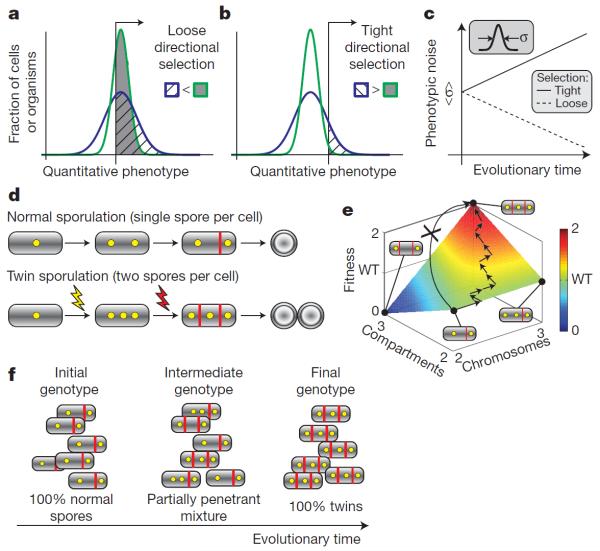Figure 4. Roles of noise in evolution.
a–c, How genetically controlled noise in a quantitative trait could respond to directional selection. a, Directional selection for values of the trait above a threshold (black line and arrow) can lead to reduced noise when the threshold is low. Thus, the noisier distribution (blue line) has less area above the threshold (cross-hatch) than a less noisy distribution (green line, grey shading) with the same mean. b, By contrast, when selection is tighter, the noisier distribution is favoured, as shown by the larger above-threshold area under the blue distribution compared to the green distribution. c, Over evolutionary timescales, noise (σ, defined as the standard variation of the distribution) would thus be expected to increase under tight selection and decrease under weak selection. In both cases, selection would also increase the mean value of the trait (not shown). d–f, Noise enables the generation of partially penetrant alternative cell fates, which facilitate discrete evolutionary changes. d, Wild-type B. subtilis cells (top) contain two chromosomes (yellow circles) when they initiate sporulation by an asymmetric division (red line). This event leads to differentiation of the forespore (smaller compartment) followed by the mother cell (larger compartment), and eventually results in formation of a single spore (white circle). Mutations can increase the frequency with which cells acquire an extra chromosome (yellow lightning) and/or an extra compartment (red lightning). Cells with both characteristics form two mature spores from a single sporulating cell (twins). e, Depending on the number of chromosomes and compartments, single cells show four distinct fates, each of which has a specific fitness (the corners of the square), assumed to be proportional to the expected number of spores it will produce. Evolution from mono-spores to twins would be difficult with a single mutation (curved arrow) as it would have to affect both septation and replication. However, several mutations affecting the penetrance of extra chromosomes and extra compartments can allow a gradual increase in the mean fitness of the population (path with multiple arrows). WT, wild type. f, This allows a gradual evolutionary transition from a homogenous population of mono-spores, to a partially penetrant intermediate population of multiple fates, to a homogenous population of twin spores.

